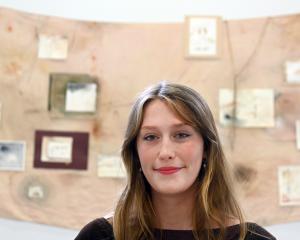"New work", Takeshi Yasuda (Brett McDowell Gallery)
Dunedin has temporarily become the centre of New Zealand's ceramics world, with several exhibitions of this related group of arts currently taking place.
Notable among these is an exhibition of fine celadon glaze porcelain by Japanese master potter Takeshi Yasuda at the Brett McDowell Gallery.
Yasuda's work combines influences from three major traditions.
His own background is Japanese, yet he has been working for some time in England, and his interests extend to Chinese porcelainware.
Over these three histories, the ceramicist has innovated with the methods used, playing with the flowing nature of both wet clay and glaze to produce works which often seem to defy gravitational constraints.
These threads combine and merge to create ceramics simultaneously rooted in the past but of no fixed locale.
The simple cylindrical shapes of the bottles with their abruptly splayed heads and the exploded forms of the bowls are seemingly basted in the gravy of luminous celadon glaze, resulting in pieces where the finger impressions of the potter and solid limpid pools of colour combine in forms which call out to be touched and caressed.
This is particularly the case with the thick platter-like form, "Plateau", with delicate lines of glaze forming calm patterns across its smooth, heavy, marble-like surface.
"Crystal glazes", Peter Gregory (Gallery on Blueskin)
A Trip to Waitati reveals the intriguing world of crystalline glazing.
This technique and look, which has fallen out of style in recent years, is undergoing something of a revival, and Peter Gregory's work shows that this revival is overdue.
Crystalline glazing lies at the border between art and science.
Glaze is supersaturated with chemical oxides, by dissolving more of them into heated glaze than could be held by the liquid at a lower temperature.
The ceramics are fired in the kiln, and as they cool, the oxides precipitate to form fanlike crystal patterns in the glaze.
The results are often beautiful and always fascinating to view.
The process is largely trial and error at first.
The glaze is difficult to work with as it has to be in a highly fluid form for the process to work.
Tiny changes in temperature can lead to differences in pattern, and different oxide mixes lead to different colours.
Over time, Gregory has studied and annotated many of these effects and is now producing impressive stoneware using cobalt, copper, magnesium, titanium and iron oxide components added to a zinc oxide-heavy glaze, creating beautifully-formed bowls and pots patterned with iridescent blues, cyans, and browns.
"Fusion 2010", The 51st national exhibition of the New Zealand Society of Potters (Otago Museum)
The highlight of the current ceramics cornucopia is "Fusion 2010".
The juried exhibition forms the centrepiece of the New Zealand Society of Potters' national conference, which is visiting Dunedin for the first time in several years.
It is an excellent opportunity to view some of New Zealand's finest contemporary ceramic work.
The exhibition also includes the work of three overseas guests, Huang Yun Peng, Victor Greenaway, and Kurt Spurey, though sadly this will not be present for the entire length of the exhibition.
The New Zealand ceramics which make up the bulk of the exhibition form an impressive display, however.
With so many pieces, everyone will find something which catches their eye.
I found myself returning to several individual works which held my fascination, among them Nicola McLaren's gorgeous impractical Handbag, Annie McIver's Crackle heart, and Fran McGuire's hypnotic Shaped by Experience.
Nicole Kolig's unusual works, formed from glaze alone, are also startlingly effective.
Among the more functional forms, Neil Grant's Chun bowl and bottles were very impressive, as were bowls by Paul Winspear and Aimee McLeod, and Greg Barron's large salt-glazed bottle.
National awards were presented at the exhibition's opening, with the top award going to Amanda Shanley's simple yet finely-worked cup, One.














